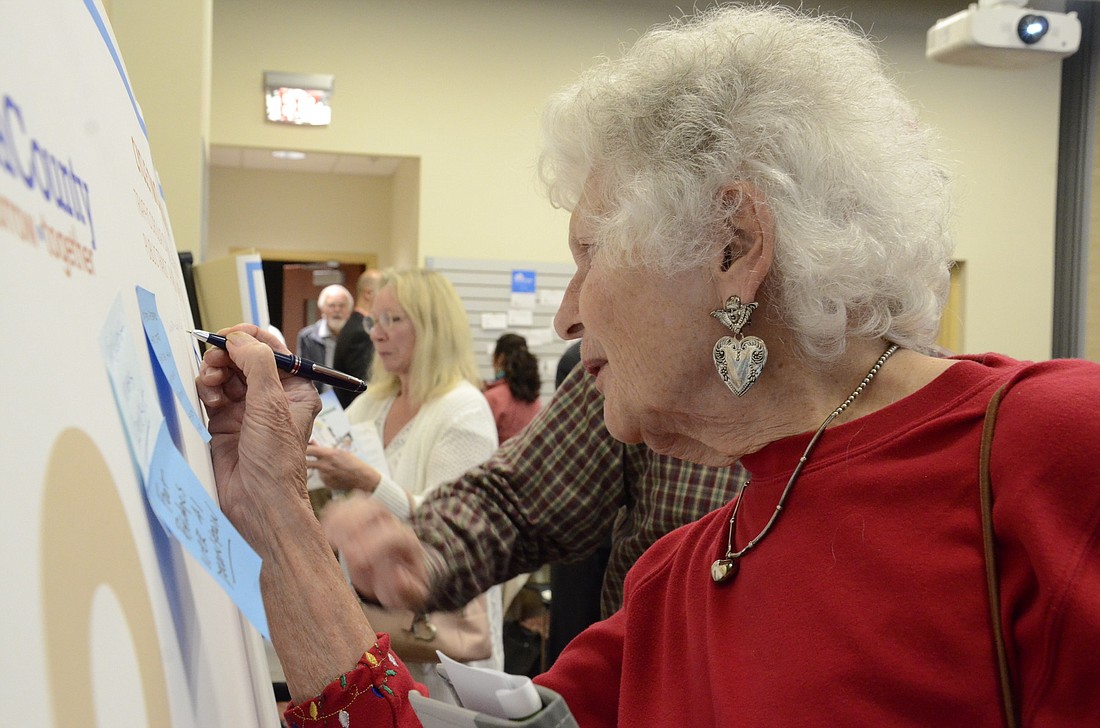- May 2, 2024
-
-
Loading

Loading

At Sarasota County’s first public meeting to outline the revision process to its comprehensive plan, staff reiterated its goal for obtaining public input as part of the process. But some community members were still apprehensive about their voices being heard at the Feb. 11 meeting.
Public input will have many avenues of submittals. Allen Parsons, planning manager, said there will be public meetings, meetings with neighborhood and community groups and online options. The county will be recording all formal public meetings and keep any pertinent documents on the county website, at scgov.net/compplanupdate. The next public meeting has not yet been set.
Public input will influence the plan in its evolution, Parsons said. One of the goals is to make the plan more understandable and easy to use, such as having more graphs and visual elements. The online version of the plan will be formatted for easier use.
“The input we receive should be reflective of goals the public has expressed,” Parsons said. “We’ll translate these goals clearly for the county.
“We’ve had people say (the plan) was hard to understand — including staff,” Parsons added.
But the lack of a Q&A section at the Feb. 11 meeting didn’t reassure some attendees.
“It’s all an illusion,” said Dan Lobeck, a local attorney with Lobeck & Hanson who has often lobbied for community concerns. “It was tightly controlled, no public discussion, no ‘hot topic’ questions.”
After the county’s decision on Sarasota 2050 amendments, Lobeck is not optimistic about the county listening to the community.
“It’s window dressing for the behind-the-scenes conversations with developers,” Lobeck said. “They ignored public opinion in the 2050 debate.”
Lobeck has been involved in county government issues for 30 years; he was involved in the last update in 2007.
Parsons said the changes made in 2007 were regulated by state policy on what had to be altered. This time, the plan isn’t tied to state prescription.
Updating the plan is a cyclical process that occurs every seven years. The county made statutory updates in August to keep the plan up to state standards, but wanted a more thorough update for the whole document.
The demographic information included in the plan is outdated, taken from the early 2000s, Parsons said. The county wants to update the plan for this, and find opportunities to improve its understandability and goals for the community.
Parsons explained that the purpose of Wednesday’s meeting wasn’t to start collecting public opinions, but to start educating those interested in participating in the process of how the updates will happen and how they can get involved.
The county is dividing different topics — everything from public transportation to waste management — into six categories, or cycles, which will be discussed for a period of eight weeks each. The seventh cycle, from March through September 2016, will compile everything into the first draft of the updated plan. It will have to go through the Planning Commission and County Commission for final approval.
“There’s no agenda except to make this plan reflect this community … to help Sarasota County to get where it wants,” Parsons said.
Kafi Benz, president of the Sarasota County Council of Neighborhood Associations, had a more positive reaction to the meeting.
“It’s a long process,” she said. “The meeting was to give information to people who want to participate.”
While some attendees weren’t happy with the lack of Q&A and the polling device used to survey the crowd — digital clickers gathered answers to multiple choice questions — Benz thought the interactive process was a good way to introduce people to data.
Benz was also involved in the last updates to the plan. The county and community worked together to reach compromises, Benz said, and she expects the same this time.
“Citizens have to participate, it’s their job,” Benz said. “Even if you have poor expectations, you have to participate.”
“We recognize that no matter how many public meetings we have, people can’t make it,” Parsons said. “We don’t want people to feel like, if they can’t make it, their input won’t be included.”
Cycle Calendar
March 2 to April 30
Environmental systems: Natural resources and conservation, coastal zone management, sustainability, climate change and green building
May 1 to June 30
Mobility: Public transit, port and rail, multi-modal facilities, pedestrian movement and bicycling
July 6 to Aug. 28
Economic development: Employee retention, skill levels, workforce and economic development initiatives
Sept. 1 to Oct. 30
Public utilities: Potable water, wastewater, storm water, solid waste and recycling
Nov. 1 to Dec. 31
Land use and urban design: Land use, neighborhoods, urban design, housing, planning districts, 2050 RMA
Jan. 4 to Feb. 28, 2016
Quality of life: Parks, libraries, historic preservation, health, public buildings and facilities, and public schools and facilities
March 1 to Sept. 30, 2016
Synergy: In this stage, the county will compile data, feedback and ideas from the other six categories into the first draft of the revised comprehensive plan. The official review process will follow, with potential completion and total approval in December 2016.